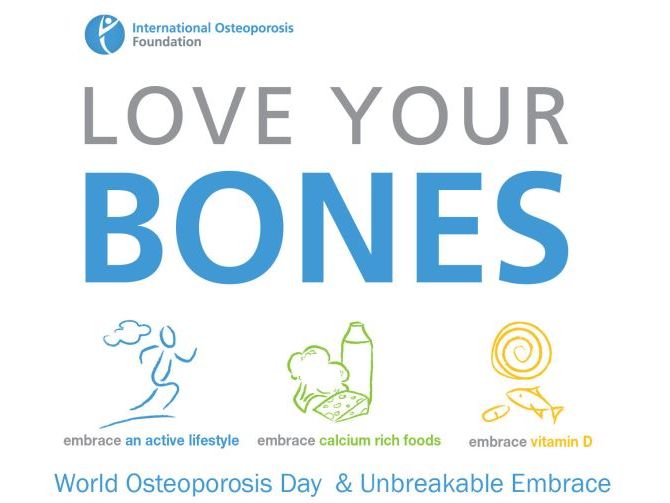On World Osteoporosis Day, I get a kick out of looking at senior dating sites.
Here’s a post I read from a foxy lady:
Sexy, fashion-conscious blue-haired beauty, 80’s, slim, 5’4′ (used to be 5’8′).
Now, why do you suppose my audiences—of men as well as women—always laugh at that post? Because they know we begin slowly shrinking as early as 50.
More and more of us over 60, especially those who haven’t exercised regularly, buy a new knee or hip. But that doesn’t necessarily put you back in running condition.
As someone who is passionate about caregiving, I have been dedicated to working with the National Osteoporosis Foundation (NOF) for many years. I advocate for knowing your family health history and talking with your daughters–and your mother—about protecting their bones.
Medicine has made great advances in correcting the deficits of our aging eyes and ears and replacing worn out body parts. But we can’t replace a spine.
Did you know that if you are over age 50 and trip on the sidewalk, fall and break a bone–any bone–it may be due to osteoporosis? It doesn’t matter where or how you fall or that you think you’re “clumsy” or you just weren’t paying attention. If you break a bone when you fall, osteoporosis may be the underlying cause.
The National Osteoporosis Foundation urges every person over 50 years old who breaks a bone to ask for a bone density test. The results of that test could make the difference between a healthy active future and a painful and limited one. Yet 80% of the time hospitals and doctors won’t offer you the painless, inexpensive test unless you ask for it. Here’s why it’s so important:
- Half of all women and up to one in four men will break a bone in their lifetime due to osteoporosis. For women, the incidence is greater than that of heart attack, stroke and breast cancer combined.
- 24 percent of hip fracture patients age 50 and over die in the year following the fracture.
- Once you break a bone, you’re at greater risk to break another one if you don’t get treatment. For fractures of the spine, called vertebral fractures, the risk of subsequent fractures is 5-fold and the risk of hip and other fractures 2-to 3-fold.
A woman might be asked about it only if she sees a rheumatologist, or endocrinologist, or a gynecologist. But according to Dr. Ethel Sirus, director of the osteoporosis center at Columbia University Medical Center, even many gynecologists are reluctant to raise the issue. Just as we did with menopause, we seasoned women have to educate ourselves and walk into a gynecologist’s office armed with the right questions. That’s the incentive they need to educate themselves about a health issue that impacts predominately older women.
My own gynecologist in New York, Dr. Pat Allen, is vigilant with her at-risk patients, reminding us to get a bone density test every two years. But the important message we need to give to our daughters is the best investment in a long and active life is to develop the habits that promote healthy bones early. The most important health conversation we can have with our daughters is about exercise. The key to keeping bones strong is developing the habit of daily exercise–young–so that as we get older, our muscles are strong enough to pull up the bones and keep the spine straight. And the body will remain limber enough to beg for regular exercise just to feel good.
My mother swam every day. We didn’t know then that the kind of exercise needed by people at risk for osteoporosis is weight-bearing – literally pounding the bones by running or daily walking, or lifting weights–so they keep rebuilding. My mother smoked for years, got lung cancer at 65, but she was cancer free by 70. It was when she could no longer enjoy reading, because her sit bones had turned to powder, that she put her head down and died.
How many fair-skinned, small-boned women over 60, or Asian women or Mexican-American women –all prime candidates for osteoporosis—go for a bone density measurement test every two years? How many know to ask their primary care doctor to measure their height and compare it to the height when they got their driver’s license? Anything over an inch & a half of height loss needs to be followed up with a spine image. A simple x-ray may be sufficient. Or, if the doctor sees evidence for it, a vertebral fracture assessment test.
The latest study by NOF find that a growing number–now 57 million Americans–have osteoporosis or are at-risk?
I worry when friends have knee or hip surgery. Recovery is slow. They often become inactive for months. Their muscles atrophy and their bones lose mass and strength which makes them vulnerable to falls and fractures. And once a bone has been broken, the person may find it painful to do weight-bearing activities. He or she won’t be highly motivated to keep up a regular exercise regimen.
What I’m hearing from the Stanford Center on Longevity is that the greatest threat to Americans’ long-term health is being sedentary. We should have signs on office walls:
SITTING FOR MORE THAN 2 HOURS AT A TIME
IS DANGEROUS TO YOUR HEALTH!
We have to educate ourselves. And be educated by our daughters! My daughter started her two girls in body movement classes before they turned one. So now, when I walk my granddaughters down the street, they swing like monkeys off every iron construction bar they see. For them, and let’s hope for you, exercise feels good.



0 Comments